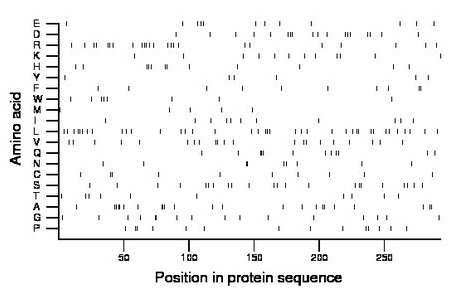
| Name: NUS1 | Sequence: fasta or formatted (293aa) | NCBI GI: 20270243 | |
|
Description: nuclear undecaprenyl pyrophosphate synthase 1 homolog
| Not currently referenced in the text | ||
|
Composition:

Amino acid Percentage Count Longest homopolymer A alanine 7.8 23 3 C cysteine 3.4 10 2 D aspartate 6.1 18 2 E glutamate 4.1 12 1 F phenylalanine 3.4 10 2 G glycine 5.5 16 2 H histidine 4.1 12 2 I isoleucine 3.8 11 1 K lysine 4.1 12 1 L leucine 13.0 38 2 M methionine 1.7 5 1 N asparagine 3.1 9 2 P proline 4.8 14 2 Q glutamine 4.1 12 3 R arginine 8.2 24 2 S serine 7.5 22 2 T threonine 3.4 10 1 V valine 7.2 21 2 W tryptophan 2.7 8 1 Y tyrosine 2.0 6 1 |
Comparative genomics:
Search single species RefSeq proteins at NCBI
Search summary 
Figure data | ||
Related human proteins:Protein Relative score Description Self-match 1.000 nuclear undecaprenyl pyrophosphate synthase 1 homolo... DHDDS 0.017 dehydrodolichyl diphosphate synthase isoform b [Homo... DHDDS 0.017 dehydrodolichyl diphosphate synthase isoform a [Homo... RGMB 0.015 RGM domain family, member B GTF2E1 0.012 general transcription factor IIE, polypeptide 1, al... GBP6 0.007 guanylate binding protein family, member 6 RBMS2 0.007 RNA binding motif, single stranded interacting protei... CBARA1 0.007 calcium binding atopy-related autoantigen 1 MYH7 0.007 myosin, heavy chain 7, cardiac muscle, beta LOC100293218 0.005 PREDICTED: similar to hCG2038990 LPIN1 0.005 lipin 1 PRSS12 0.005 neurotrypsin precursor GPR112 0.005 G-protein coupled receptor 112 CAMK1D 0.005 calcium/calmodulin-dependent protein kinase ID isofor... CAMK1D 0.005 calcium/calmodulin-dependent protein kinase ID isofo... LOC100293175 0.005 PREDICTED: hypothetical protein LOC100291458 0.005 PREDICTED: hypothetical protein XP_002347107 LOC100288099 0.005 PREDICTED: hypothetical protein XP_002342970 HAL 0.005 histidine ammonia-lyase WDFY4 0.005 WDFY family member 4Human BLASTP results (used to prepare the table) | |||
Gene descriptions are from NCBI RefSeq. Search results were obtained with NCBI BLAST and RefSeq entries. When identical proteins are present, the self-match may not be listed first in BLASTP output. In such cases, the table above has been reordered to place it first.
See About the Figures for the scoring system used in the figure above right. The same scoring system was used in the table of BLASTP results.
Guide to the Human Genome
Copyright © 2010 by Stewart Scherer. All rights reserved.
